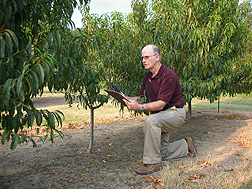Washington, DC, USA
November 29, 2011
Planting tall fescue grass as a ground cover in peach orchards helps protect peach trees from nematodes that attack tree roots, according to U.S. Department of Agriculture (USDA) scientists.
 In a study published in the Journal of Nematology in 2010, Agricultural Research Service (ARS) plant pathologists Andy Nyczepir (photo) at the Southeastern Fruit and Tree Nut Research Laboratory in Byron, Ga., and Susan Meyer at the Nematology Laboratory in Beltsville, Md., tested several tall fescue varieties to find out if they could thwart four troublesome root-knot nematode species-Meloidogyne incognita, M. hapla, M. javanica, and M. arenaria.
In a study published in the Journal of Nematology in 2010, Agricultural Research Service (ARS) plant pathologists Andy Nyczepir (photo) at the Southeastern Fruit and Tree Nut Research Laboratory in Byron, Ga., and Susan Meyer at the Nematology Laboratory in Beltsville, Md., tested several tall fescue varieties to find out if they could thwart four troublesome root-knot nematode species-Meloidogyne incognita, M. hapla, M. javanica, and M. arenaria.
ARS is USDA's principal intramural scientific research agency, and the research supports the USDA priority of promoting international food security.
In the study, Nyczepir and Meyer found that a commercial tall fescue, MaxQ, prevented M. incognita and M. hapla from reproducing. M. javanica has a low level of reproduction on MaxQ, but M. arenaria can reproduce on it.
Traditionally, growers have fumigated peach orchard soils prior to planting and then used a nematode-resistant rootstock. But in recent years, growers have faced tough times that have made it difficult to afford preplant fumigants, such as Telone II or Vapam. Many growers also have difficulty fumigating at the recommended time of year because of conflicts with managing other crops.
In Georgia, rotation with coastal Bermuda grass, which can also be harvested for hay, is recommended for control of root-knot nematode. According to Nyczepir, their studies show that MaxQ may have potential as a preplant control strategy for M. incognita and M. hapla in southeastern and northeastern areas of the United States. Using this tall fescue as a preplant cover crop treatment may allow growers to reduce the use of chemical nematicides.
Preliminary data from the team's field trials using MaxQ as a preplant cover crop have so far found that peach trees planted after the cover crop are larger than those planted in soil that is not fumigated.
Read more about this research in the November/December 2011 issue of Agricultural Research magazine.
Photo by Merry Bacon.
La festuca alta ayuda a proteger los melocotoneros contra los nematodos
Sembrar el césped llamado la festuca alta como un cultivo de cobertura en los huertos de melocotoneros ayuda a proteger los árboles contra algunos nematodos que atacan las raíces de los árboles, según científicos del Servicio de Investigación Agrícola (ARS).
En un estudio con resultados publicados en 'Journal of Nematology' (Revista de Nematología) en el 2010, patólogos de plantas Andy Nyczepir, quien trabaja en el Laboratorio del Sudeste de Investigación de Frutas y Frutos Secos mantenido por el ARS en Byron, Georgia, y Susan Meyer, quien trabaja en el Laboratorio de Nematología mantenido por el ARS en Beltsville, Maryland, probaron varios variedades de la festuca alta para determinar su capacidad de combatir cuatro especies de nematodos agalladores de las raíces–Meloidogyne incognita, M. hapla, M. javanica, y M. arenaria.
ARS es la agencia principal de investigaciones científicas del Departamento de Agricultura de EE.UU. (USDA por sus siglas en inglés), y esta investigación apoya la prioridad del USDA de promover la seguridad alimentaria internacional.
En el estudio, Nyczepir y Meyer descubrieron que una variedad comercial de la festuca alta llamada MaxQ impidió la reproducción de M. incognita y M. hapla. M. javanica tiene un nivel bajo de reproducción en la presencia de MaxQ, pero M. arenaria si puede reproducirse en el césped.
Tradicionalmente, los cultivadores han fumigado los suelos de huertos antes de plantar los melocotoneros y luego usaron un patrón de melocotonero que tienen resistencia a los nematodos. Pero en los años recientes, los cultivadores no pudieron pagar los costos de usar los fumigantes tales como Telon II o Vapam antes de plantar los árboles. Muchos cultivadores también tuvieron dificultades en aplicar la fumigación en el momento apropiado debido a conflictos relacionados con el manejo de otros cultivos.
En Georgia, se recomienda plantar el pasto Bermuda, el cual puede ser una fuente del heno, en rotación con otros cultivos para controlar el nematodo agallador. Según Nyczepir, sus estudios demostraron que MaxQ podría tener potencial como una estrategia antes de plantar para controlar M. incognita y M. hapla en las regiones del sudeste y el noreste de EE.UU. Utilizar este pasto como un tratamiento antes de plantar los melocotoneros podría ayudar a los cultivadores a reducir el uso de productos químicos contra los nematodos.
Los datos preliminares de las pruebas de campo utilizando MaxQ como un cultivo de cobertura han demostrado que los melocotoneros plantados después del cultivo de cobertura son más grandes que aquellos plantados en el suelo no fumigado.
Lea más sobre esta investigación en la revista 'Agricultural Research' de noviembre-diciembre del 2011.